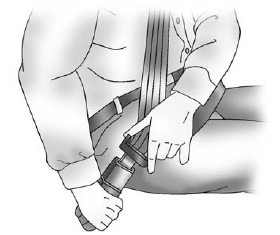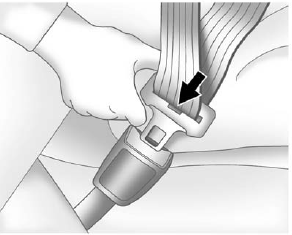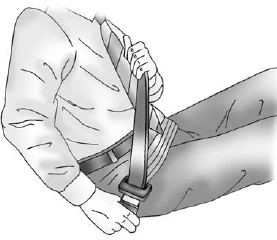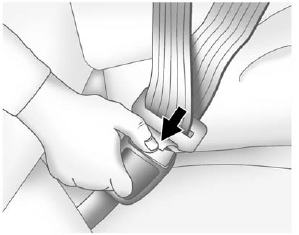Lap-Shoulder Belt
All seating positions in the vehicle have a lap-shoulder belt.
If you are using a rear seating position with a detachable safety belt and the safety belt is not attached, see “Returning the Seat to the Seating Position” under Third Row Seats on page 3‑12 for instruction on reconnecting the safety belt to the mini-buckle.
The following instructions explain how to wear a lap-shoulder belt properly.
1. Adjust the seat, if the seat is adjustable, so you can sit up straight. To see how, see “Seats” in the Index.

2. Pick up the latch plate and pull the belt across you. Do not let it get twisted.
The lap-shoulder belt may lock if you pull the belt across you very quickly. If this happens, let the belt go back slightly to unlock it.
Then pull the belt across you more slowly.
If the shoulder portion of a passenger belt is pulled out all the way, the child restraint locking feature may be engaged.
If this happens, let the belt go back all the way and start again.

3. Push the latch plate into the buckle until it clicks.
4. Pull up on the latch plate to make sure it is secure. If the belt is not long enough, see Safety Belt Extender on page 3‑22.
Position the release button on the buckle so that the safety belt could be quickly unbuckled if necessary.
5. If equipped with a shoulder belt height adjuster, move it to the height that is right for you.
See “Shoulder Belt Height Adjuster” later in this section for instructions on use and important safety information.

6. To make the lap part tight, pull up on the shoulder belt.
It may be necessary to pull the stitching on the safety belt through the latch plate to fully tighten the lap belt on smaller occupants.

To unlatch the belt, push the button on the buckle. The belt should return to its stowed position. Slide the latch plate up the safety belt webbing when the safety belt is not in use. The latch plate should rest on the stitching on the safety belt, near the guide loop on the side wall.
Before a door is closed, be sure the safety belt is out of the way. If a door is slammed against a safety belt, damage can occur to both the safety belt and the vehicle.
See also:
Tires
Use a stiff brush with tire cleaner to clean the tires.
Notice: Using petroleum-based tire dressing products on the vehicle may damage
the paint finish and/or tires. When applying a tire dressing, ...
Other Rainy Weather Tips
Besides slowing down, other wet weather driving tips include:
• Allow extra following distance.
• Pass with caution.
• Keep windshield wiping equipment in good shape.
• Keep the windshield ...
Brake System Messages
BRAKE FLUID LOW
This message is displayed when the brake fluid level is low; see Brake Fluid
on page 10‑24.
RELEASE PARKING BRAKE
This message is displayed as a reminder that the parking br ...





